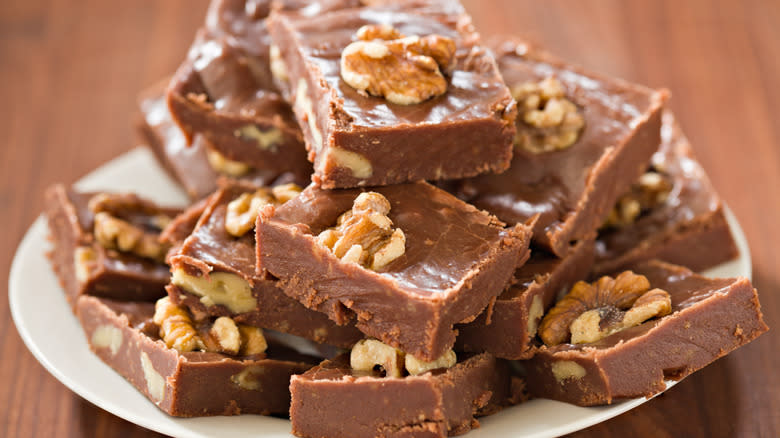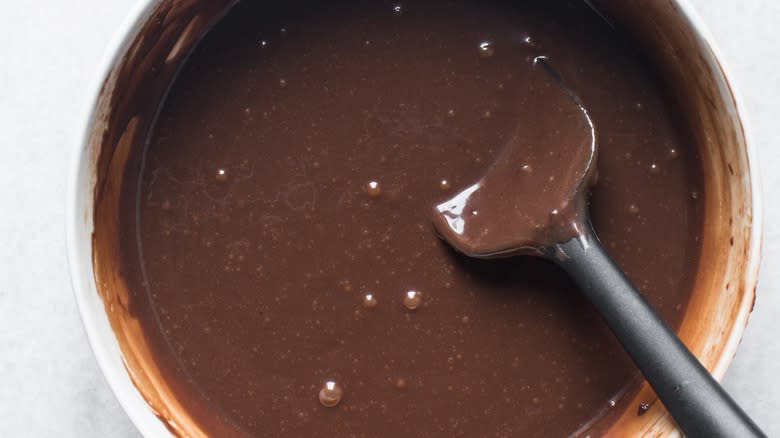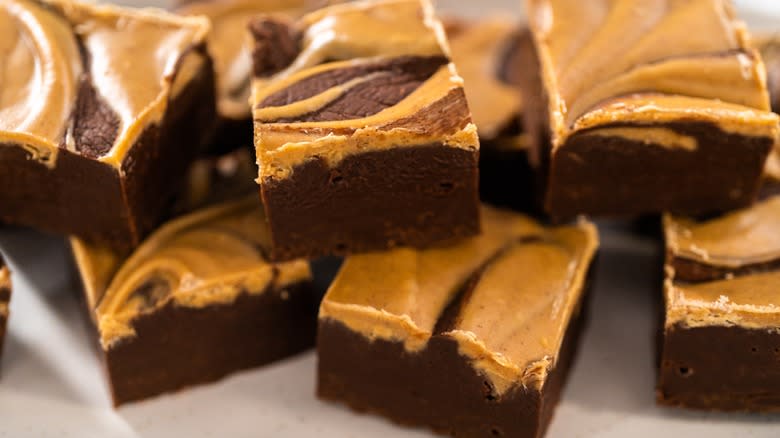The One Stage Of Fudge-Making You Don't Want To Mess Up

The very best fudge is the kind that's silky smooth, and when it's made right, it's truly something to behold. When the process goes wrong, however, it can turn even your favorite caramel pecan fudge grainy. Fortunately, there's an easy way to avoid making the mistake that can completely ruin the texture of your fudge and a neat scientific explanation as to why that grainy crystallization happens.
First, let's talk about what you need to do to get that creamy smoothness. Fudge can develop an undesirable graininess during the cooling period after you've heated and melted your ingredients. Temperature control — and a good thermometer — is important, and you'll want to aim for a melting point of 235 degrees Fahrenheit. That's the soft-ball stage, which is when your ingredients essentially bind to form fudge. The next step is letting it cool — and this is what you don't want to mess up.
The recipe will tell you to cool your fudge mixture to between 110 and 130 degrees Fahrenheit, and during that cooling period, you mustn't stir it. Don't move the pot: Leave it alone, aside from the occasional temperature check. It's during this cooling stage that crystals form, and it'll turn fudge from smooth to grainy. This is due to a fascinating bit of chemistry that happens in other candy-making recipes, too, and while in some it can be exactly what you want, it's what you want to avoid in fudge.
Read more: Cake Hacks Every Baker Will Wish They Knew Sooner
The Texture In Candy Comes From The Formation Of Seed Crystals

Fudge's texture comes from the way sugar first breaks down and then reforms. At the start of the process, sugar dissolves into individual molecules, which can then reform around other, slightly larger molecules called seed crystals. Exactly what a seed crystal is can vary, and it could be something as simple as an air bubble or a few sugar molecules that are stuck together. If too many sugar molecules stick to the seed crystals during the cooling process, the crystals will be large, and the fudge will take on that undesirable grainy texture. If you wait until it's cool to start stirring, the cooler mixture will form not large crystals with a coarse texture but many smaller, smoother crystals.
It's also important to note that once you start stirring, continuous movement of the mixture will encourage the development of those tiny, smooth crystals. The fudge will continue to cool, molecules will continue to look for other molecules to bind to, and continuing to stir will keep those crystals small. This principle of binding sugar molecules is important not only in making fudge but most candies. Some kinds of candy — like gummies — get their texture from having no crystals, while rock candy is at the other end of the spectrum and is created when those crystals are encouraged to form.
You Can Fix Grainy Fudge By Breaking Up The Sugar Crystals

Let's say you're whipping up a batch of your favorite peanut butter fudge, and it doesn't turn out quite like you expected. It could be possible to fix fudge if it comes out grainy, and it essentially means re-melting the mixture to break those grainy molecules apart again and properly cooling it to keep them from reforming.
There are a few things to keep in mind here, starting with the fact that depending on what went wrong with your fudge in the first place, it might be hard to fix. Large, grainy crystals can form around foreign matter that ends up in your fudge, which can be something as imperceptibly tiny as bits of dust. Sugars that aren't completely melted into the molecular components can also act as seed crystals, and if you've added nuts to your mixture, it can be hard to keep that grainy texture from forming.
If you're struggling with getting that perfect smooth, silky texture, there are a few things you can try. Some additives will prevent large crystals from forming: Add fats — in the form of butter or cream — to the mix to block the binding reaction that happens around those seed crystals. A bit of corn syrup or cream of tartar will also help prevent those molecular bonds from forming and could be the secret ingredient to your perfect fudge.
Read the original article on The Daily Meal.


